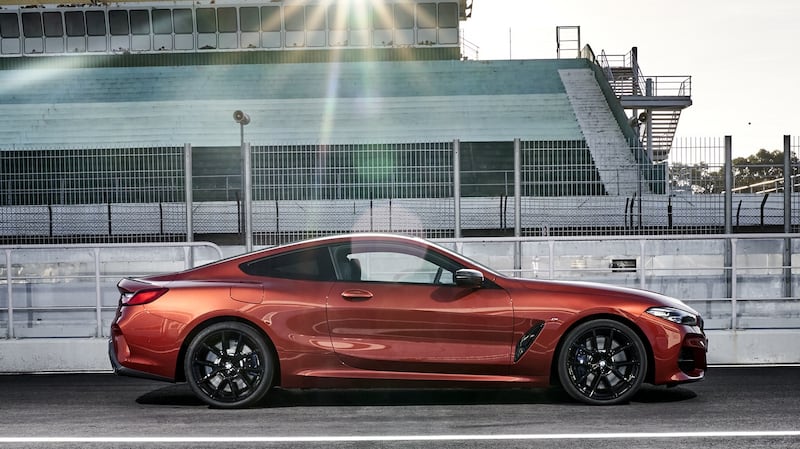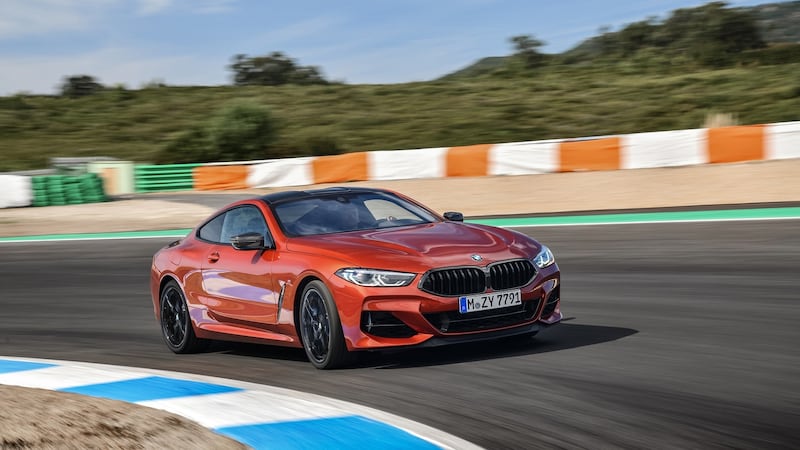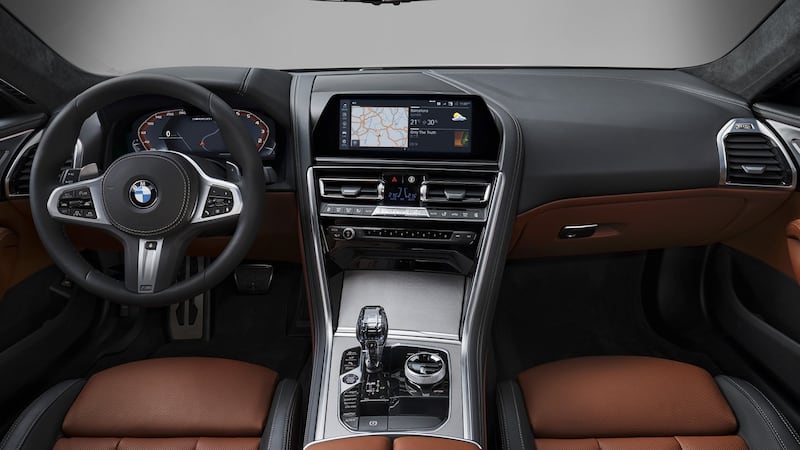The pressure is on for even mainstream premium cars to go faster and faster. And the German premium brands are locked in a spiral of chasing speed with the top ends of their ranges.
Enter, stage left the M850i xDrive: a stunning looking car that's as fast as any non-M division BMW has ever gone.
Bursting to 100km/h in 3.7 seconds is stupendously impressive, given the go-faster M8 won’t be seen until March next year, but cars like the M850i xDrive spotlight some of the subconscious discomfort behind for the dawning of the EV era, with companies misusing their resources to deliver sports-car speed from overweight machines when they could easily sacrifice some of that for the efficiency that could preserve their social legitimacy.
What’s also true, though, is that fans and buyers demand decreasing 0-100km/h times because it’s about the only benchmark they have. And because buyers want them to be faster, that’s how carmakers will deliver them.
Besides, BMW insists, any difference between a 3.9-second M850i and a 3.7-second one is all in the eight-speed transmission’s launching and shifting capabilities, not in using any extra fuel or burping out any extra emissions.
I've got to admit that I was a bit cynical about the M850i, until about five corners in to the Estoril racetrack near Lisbon.
Cars this big will rarely ever sidle up at track days, especially not when every hard-won apex take hefty bites out of the tyre, fuel and brake budgets, but its grip levels and its ease of operation at the upper limits of its handling range can only safely be done on a closed circuit.
And they can only be done on a circuit because the limits are just so high, and so impressive. Yes, there is weight there aplenty. It’s always front and centre in every thought process from the start of the braking area until when you start picking up the throttle again.
But it's weight without tardiness, and it changes direction with surprising enthusiasm, it hustles its power down onto the road with incredible success and it's always stable, even when it's completely beyond the lateral grip limits of its Pirelli rubber.
The odd part about the M850i is that it's priced at about the same point as the Mercedes-Benz S550 Coupe, but it must have been designed with a completely different grand-touring driver in mind.
The Benz targets comfort and refinement, and delivers its handling from behind a genteel mask and an overwhelming feeling of unflappability. The BMW doesn’t do that.
It can do luxury, but it targets the handling and the hammering first and foremost, with comfort and, in particular, refinement coming in a clear second.
Oh, and there’s no space in the back for adults or teenagers, especially if they have legs. Or heads. Or legs and heads at the same time.

The 8 Series is all about going places. Quickly.
For all BMW’s talk about modular engines, the V8 remains very much not like that at all. In the ideal BMW world, it would be a 4.0-litre V8, just like Audi’s, Mercedes-Benz’s and Porsche’s V8s.
It’s a 4.4-litre V8 because BMW says the Americans like a bigger capacity. The real reason is that its planned cycle time hasn’t finished yet, so it just keeps receiving updates.
The 4395cc motor is strong, everywhere, though it’s not a stratospherically high revver. (To be fair, nothing in the BMW lineup is a stratospherically high revver anymore.)
Instead, it gives you 750Nm of torque from 1,800rpm, then holds it until 4,600rpm, while its 390kW of power is stamping its authority at 5,500rpm and holding on to that until 6,000rpm. And while the M850i’s V8 can spin a little higher, to 6,500rpm, there’s not much reward to be extracted from it.
It’s a formidable engine, and it sounds and feels formidable all the time. Yes, its Eco and Comfort modes include the engine in their remits, but all they really do is pull its lips back over its teeth.
There’s none of that in Sport or Sport Plus and the M850i barks, growls, snaps and crackles. There’s a slight, seemingly intentional coarseness to it at low revs to highlight its performance, with someone evidently thinking the hit to the spine was too ambiguous.
BMW has paid attention to detail to get there, lifting the fuel-injection pressure from 200 to 350 bar, which helps with fuel metering and lowering the emissions.
And about that. The M850i pushes out 9.8 litres/100km, which is just 0.1 litres fewer than the M5 did before they polished it up this time around, and it emits 224 grams of CO2/km. And that’s with two larger close-coupled catalytic converters and particulate filters. So it’s not brilliant on the fuel economy front.
Other oily bits
A massive key to the M850i’s straight-line performance is its eight-speed automatic transmission. Other carmakers source their autos from ZF as well, but none seem to be able to deliver the positive engagement of the BMW units.
And this is another example of that. The car’s engineering leader insisted they found between two and three tenths of a second to 100km/h shared between the launch control and the shifting performance of the magnificent eight-speeder.
Technically, the M850i is an all-wheel drive car, but it's really a rear-wheel drive car with an on-demand front differential
The shifts might be precise when it’s attacking, but they’re positive, rather than shocking. It’s not bad when the car’s cruising, either, with a wider spread of gear ratios and the transmission is also lighter than it was in the 6-Series.
Technically, the M850i is an all-wheel drive car, but it’s really a rear-wheel drive car with an on-demand front differential. If the car’s cruising on a highway or dawdling around town, then it’s a rear-wheel drive car. Even when the all-wheel drive system kicks in, it still holds on to a rear-drive posture and feeling.
The 8 Series in our test car also boasted rear-wheel steering and BMW’s electronically controlled rear diff lock as standard kit and it all works seamlessly together, rather than as separate units. The driver never feels one thing beginning and the other ending.
The only time you can really feel something moving independent of the other oily stuff is when you’re moving into a low-speed bend and the weight begins to force the nose away from your chosen line. Then the rear steer does its thing and the nose of the car suddenly tugs itself back where you wanted it to go. It’s uncanny and intuitive.

The 8 Series rides on the same architectural base as the 5-Series and the new Z4, so its chassis is a mix of high-strength steels, aluminium and carbon-fibre. And somehow it still weighs in at 1,965kg.
It’s a technically sophisticated number, with a five-link rear end and a double wishbone front end, the upshot of which is a car that does its very best to hide its weight, but it never does it with complete success until the rear-steering kicks in.
The issue isn’t the car’s speed - it’s got plenty, topping out at 250km/h - but its refinement. It handles better than it ought to, which has been the trick of the engineers, and it does it with precise steering (especially in its sport modes, where it adds weight and feedback) and remarkably calm chassis work.
It holds tremendous speed in long, fast bends, but also whips through tighter corners and direction changes in a way that is eyebrow-raising. It’s even happy in the wet, with the diff and all-wheel drive able to turn all that torque into all that punch, time and time again.
It will slide with the DSC skid control in its one-push setting, but only enough to be easily recoverable for even moderately skilled operators.
It also rides reasonably well over broken ground, but it’s a very big car, at nearly 5 metres long and 1.9 metres wide, so it should.
Where it falls down against its Stuttgart rival is in refinement. The chassis or the intent doesn't deliver it like the S-Class Coupe does. There's more engine noise, more wind noise and more road noise in the cabin, in every circumstance, and it never imparts the same sense of calm to its operators, even though its operating ceiling is higher.
Life on the inside
Let’s start at the back seat: there isn’t one. Well, there is one. It’s clearly there, with a sculpted bench behind the front seats that look for all the world to be seats. Except you can’t sit in them. My daughter couldn’t sit in them and she’s about five. Headroom doesn’t exist, knee room doesn’t exist, shoulder room doesn’t exist and good luck keeping your toes.

So, unlike the moderately useful S-Class Coupe rear seats, the M850i's are more like the Porsche 911 rear seats, and their inability to house actual people hasn't much hurt the 911 over the years.
They do fold down, though, with a 50:50 split and push-button folding allow people to add to the taking the boot’s 420-litre capacity.
The front seats are a pretty smart place to be, though.
They are trimmed nicely, they’re comfortable, with electric adjustment in every direction, and they fold over and slide forward at the pull of a strap to allow people out of the rear seats and, presumably, into their wheelchairs.
They have integral headrests, too, which is both good and bad (some people can find that they rub their heads against them constantly), and they’re surrounded by a pair of cupholders, large door pockets and a split-covered armrest that hides a pretty big console area.
The dash carries is a 12.3-inch fully digital instrument cluster paired to a 10.25-inch infotainment touch screen, and most of the interior’s functions are run by touching and swiping the smaller of the two screens.
The trouble is that some tasks that were one-touch are now three or five touches of the screen, leaving you with your eyes off the road for far longer than is ideal. There’s also a concern that the tech is outpacing some of the older sections of the buyer profile.
And if you’re going to go that far, you might as well take the optional glass gear-lever top, with an “8” visible through it’s panelled surface.
Overall, the 8-Series is shorter, better looking, easier to drive and faster than the 6-Series it replaces, and the M850i is a very impressive range-topper - so far. It’s a terrific (if heavy) premium grand coupe, capable of delivering everything the looks promise, so long as you don’t have to sit in the back.











